【精彩课堂】Unit 3 单元知识点讲练课件— 2025-2026学年九年级英语上册同步精品课件(人教版)
文档属性
| 名称 | 【精彩课堂】Unit 3 单元知识点讲练课件— 2025-2026学年九年级英语上册同步精品课件(人教版) |  | |
| 格式 | pptx | ||
| 文件大小 | 17.0MB | ||
| 资源类型 | 试卷 | ||
| 版本资源 | 人教新目标(Go for it)版 | ||
| 科目 | 英语 | ||
| 更新时间 | 2025-08-29 18:26:42 | ||
图片预览

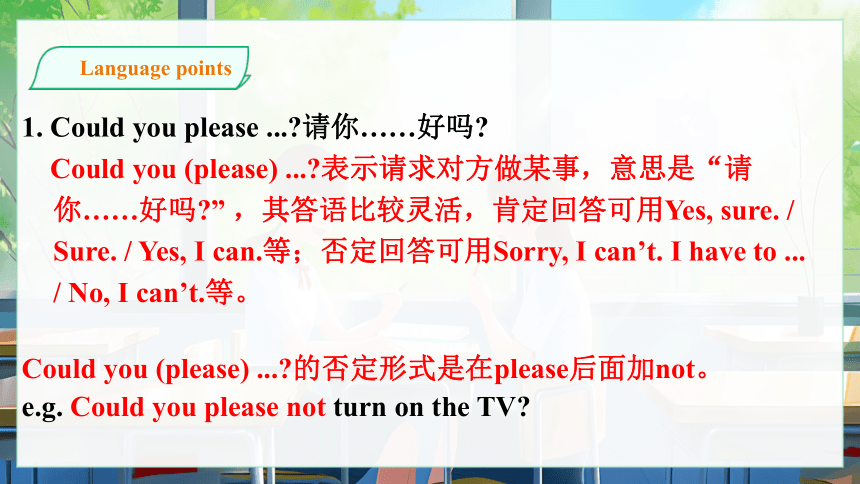


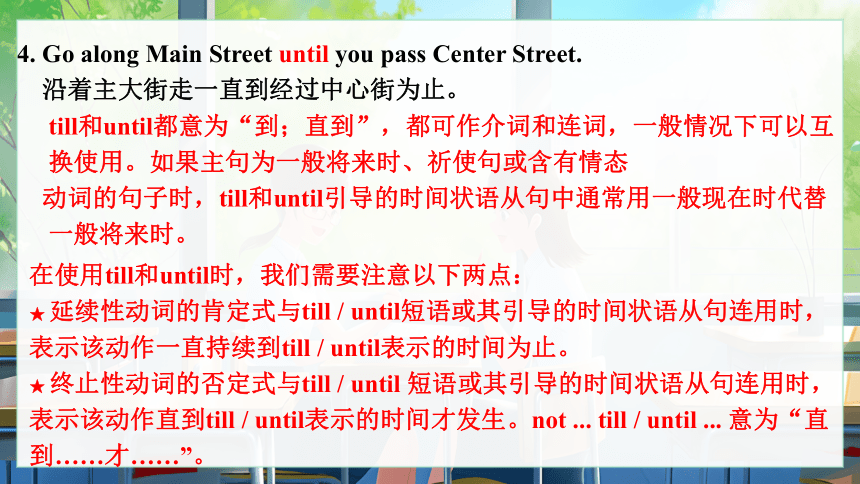



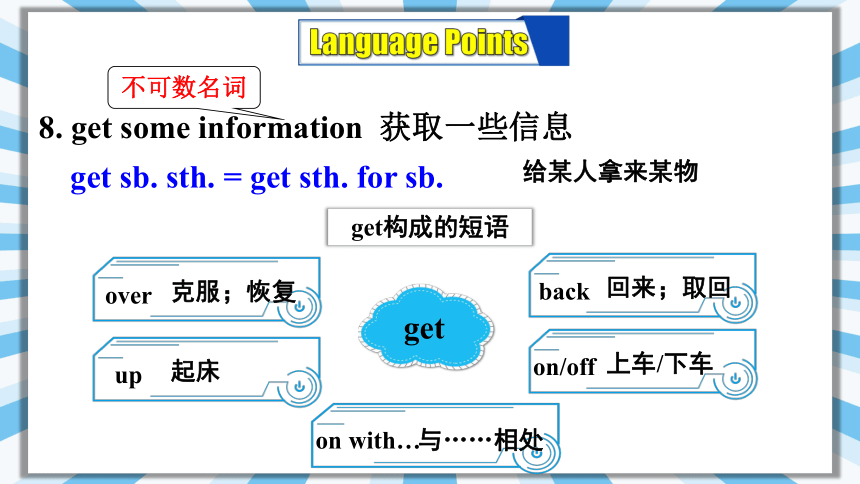
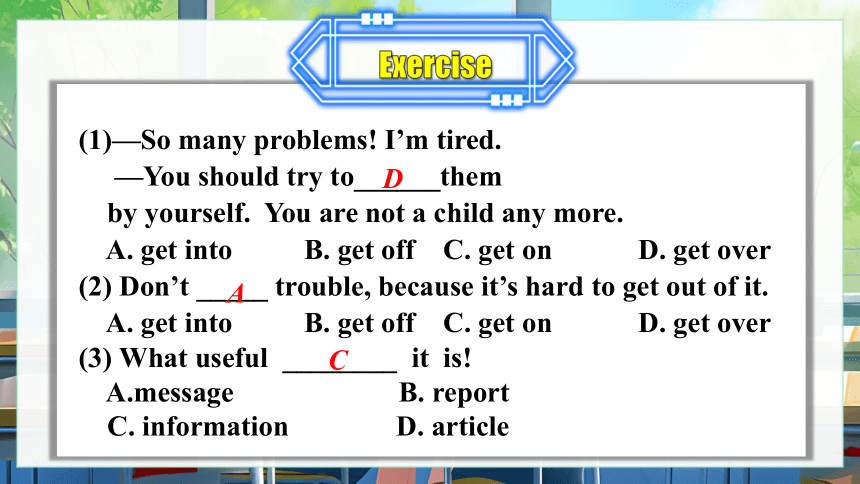
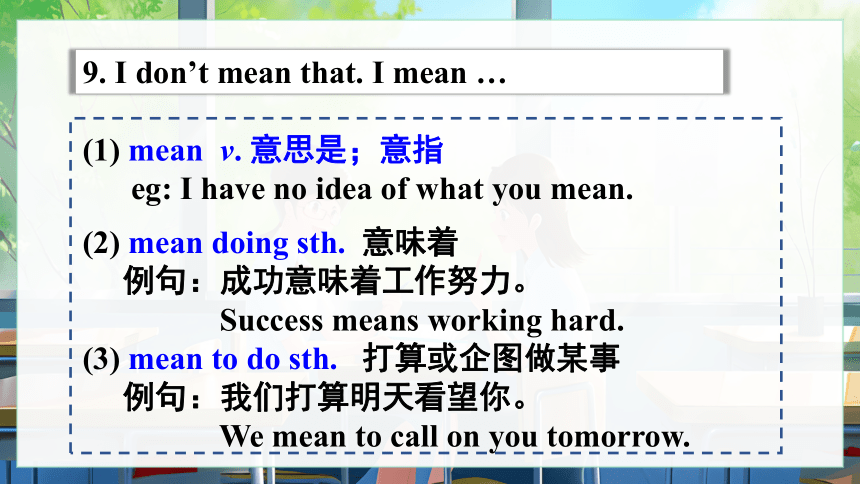
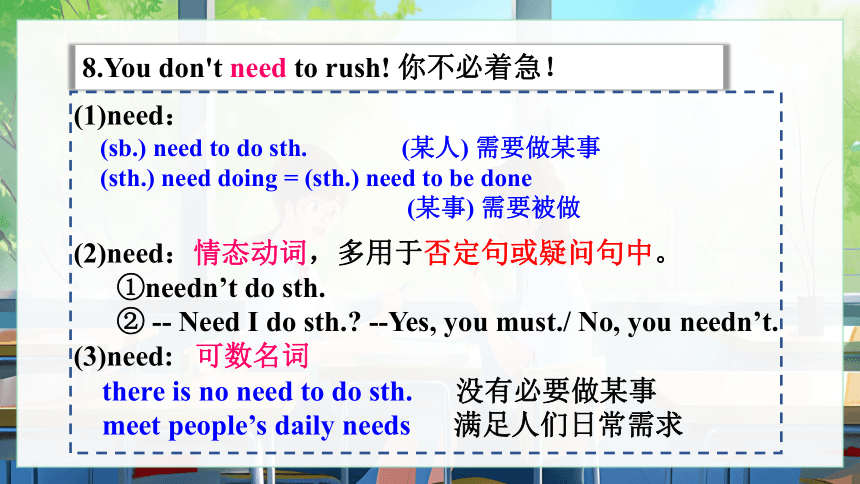
文档简介
(共48张PPT)
Unit 3
Could you please tell me where the restrooms are
单元知识点精讲精练
Language points
1. Could you please ... 请你……好吗
Could you (please) ... 表示请求对方做某事,意思是“请你……好吗 ” ,其答语比较灵活,肯定回答可用Yes, sure. / Sure. / Yes, I can.等;否定回答可用Sorry, I can’t. I have to ... / No, I can’t.等。
Could you (please) ... 的否定形式是在please后面加not。
e.g. Could you please not turn on the TV
Could I / We ... 表示请求得到对方的许可,意思是“我 / 我们可以……吗 ” ,其答语比较灵活,肯定回答可用Yes, you can. / Of course. / Sure.等;否定回答可用Sorry. / No, you can’t.等。
e.g. —Could we go for a picnic this weekend
—Yes, you can. But you have to finish your
homework first.
—Could I borrow your pen
—No, you can’t.
Language Points
1) “疑问词+动词不定式”充当宾语。
e.g. Do you know how to solve the problem
你知道如何解决这个问题吗?
2) “疑问词+动词不定式”可以转化为宾语从句。
e.g. Could you tell me how I can get to Center Street
Do you know how I can solve the problem
2. Could you tell me how to
get to Center Street
4. Go along Main Street until you pass Center Street.
沿着主大街走一直到经过中心街为止。
till和until都意为“到;直到”,都可作介词和连词,一般情况下可以互换使用。如果主句为一般将来时、祈使句或含有情态
动词的句子时,till和until引导的时间状语从句中通常用一般现在时代替一般将来时。
在使用till和until时,我们需要注意以下两点:
★ 延续性动词的肯定式与till / until短语或其引导的时间状语从句连用时,表示该动作一直持续到till / until表示的时间为止。
★ 终止性动词的否定式与till / until 短语或其引导的时间状语从句连用时,表示该动作直到till / until表示的时间才发生。not ... till / until ... 意为“直到……才……”。
5. Go past the bookstore.
经过书店。句中的past是介词,意为“经过”,常和walk, run, go等表示位移的动词连用。
past 词性 词义 例句
副词 经过 The cars go past once an hour.
名词 过去(常与the连用) We cannot change the past.
形容词 过去的 Forget those past unhappy things.
6. I’m excited to try the rides!
我很兴奋来尝试这些游乐设施!excited作形容词,意为“激动的;兴奋的”,常用来描述人的感受。
excited & exciting
excited意为“激动的;兴奋的”。作表语时,主语通常是人;作定语时,常用来修饰人。
e.g. Steve will fly home tomorrow. We’re all excited when hearing the news.The excited fans are waiting (等待) for the singer to arrive.
7. Pardon Restroom You want to rest But we haven’t even started yet!
什么?休息室?你想要休息了?我们可还没有开始玩呢!
◆作动词,意为“原谅”,短语pardon sb. for
doing sth.意为“原谅某人做某事”。
◆pardon me常用于以下场合,且与excuse me同义:
6. You don’t need to rush! 你不用着急。
◆作动词,意为“仓促;急促”,常用表达有 Don‘t rush. (别急。);rush to do sth.(急忙做某事);rush out of ... (冲出……);rush into doing sth.(仓促行事)。
8. get some information 获取一些信息
get sb. sth. = get sth. for sb.
给某人拿来某物
get构成的短语
不可数名词
Language Points
get
back
回来;取回
on/off
上车/下车
on with…
与……相处
up
起床
over
克服;恢复
(1)—So many problems! I’m tired.
—You should try to______them
by yourself. You are not a child any more.
A. get into B. get off C. get on D. get over
(2) Don’t _____ trouble, because it’s hard to get out of it.
A. get into B. get off C. get on D. get over
(3) What useful ________ it is!
A.message B. report
C. information D. article
D
A
C
Exercise
9. I don’t mean that. I mean …
(1) mean v. 意思是;意指
eg: I have no idea of what you mean.
(2) mean doing sth. 意味着
例句:成功意味着工作努力。
Success means working hard.
(3) mean to do sth. 打算或企图做某事
例句:我们打算明天看望你。
We mean to call on you tomorrow.
8.You don't need to rush! 你不必着急!
(sb.) need to do sth. (某人) 需要做某事
(sth.) need doing = (sth.) need to be done
(某事) 需要被做
(1)need:
(2)need:情态动词,多用于否定句或疑问句中。
①needn’t do sth.
② -- Need I do sth. --Yes, you must./ No, you needn’t.
(3)need: 可数名词
there is no need to do sth. 没有必要做某事
meet people’s daily needs 满足人们日常需求
Exercise
You_____angry with her, for she is too young.
A.need not to be B. do not need to
C.need not be D.need not
2. --______ I hand in my homework now
--Yes, you _______.
A. Must , needn’t B. Must, need
C. Need, need D. Need, must
3. The bike needs _________.
A. to repair B. to be repair
C. repairing D. to repairing
C
D
C
9.rush v. / n. “仓促,急促”
常用短语:
rush to do sth. = do sth. in a rush 匆忙做某事
rush to sp. 冲向某地
rush hour(s) (交通)高峰期,拥堵时刻
即时演练:
翻译: 他跳起来向门口冲去。
He jumped up and rushed to the door.
他今天匆匆忙忙去上学了。
He went to school in a rush this morning.
10. I wonder where we should go next.
wonder 意为“想知道;对……感到怀疑”后接 who, what, why, where 等引导的宾语从句。
1) I wonder who she is.
我想知道她是谁。
2) Your parents will be wondering where you are.
你父母会想知道你在哪里。
11. How about that new ride over there
How about … 意思是“……怎么样? ”, 表示建议、征求意见,相当于 What about…
How about next week
下星期怎么样?
How about going to a concert
去听音乐会如何?
12. I promise it’ll be exciting!
promise v. 允诺,答应, 保证
promise to do sth.允诺/答应/保证做某事
1) She's promised to do all she can to help.
她答应尽力帮忙。
2) The government promised to look into the matter.
政府承诺研究这个问题。
3) 'Promise not to tell anyone!' 'I promise.'
“你要保证不告诉别人!”“我保证。”
13. If you’re afraid, just shout or hold my hand.
shout 作动词,意为“呼喊;呼叫;大声说”。
常用短语
(l) shout at sb. 意为“冲某人大声叫嚷”,含有批评、指责的意思。
Don’t shout at your parents.
(2) shout to sb. 意为“对某人大声叫喊”,没有批评、指责的意思。
He shouted to the girl and warned her of the danger.
(3) shout out 意为“喊出;突然呼喊”。
Only a few people are brave enough to shout out her name.
抓紧我的手
14. I was scared at first, but shouting did help.
此句相当于 I was scared at first, but shouting helped. 原句是一种表现强调的句式。
e.g. Please do be careful. 请一定小心。
I do agree with you. 我完全同意你的意见。
He did warn you other day, remember
他前两天就告诫过你, 还记得吗?
英语中, 可用助动词do对谓语动词进行强调, 构成强调句。
15. You never know until you try something.
常用结构:try to do sth. 设法做某事 try doing sth. 试着做某事
try v. 尝试;设法;努力
until意为“到…时,直到…为止”
用于否定句,not...until的意思是“直到…才”,引导时间状语从句
He didn’t leave the office until he finished his work.
他完成工作才离开了办公室。
16. I suggest Water City Restaurant in Water World.
suggest 意思为____________
v.建议;提议
suggest doing sth.
“建议”
动词
名词
suggest
advise
advise sb. (not)to do
advise doing sth.
suggestion
可数名词
advice
不可数名词
suggest sth.
17. On their way to Water City Restaurant, Alice and He Wei pass by Uncle Bob’s.
关于way的短语:
by the way 顺便说一声 in a way 在某种程度上
in the way 挡道;妨碍 in no way 绝不
lose one’s way 迷路 make one’s way to 前进
in this way 这样,通过这种方法
on one’s way to … 在某人去……的路上
1)
pass by 还有“(时间)逝去;过去”的意思。此时同go by.
拓展
pass by 作及物动词,意为____________.
路过;经过
相当于 go past, pass 是动词,past 是介词。
我昨天晚上大约十点路过你家。
I ___________ your house at about 10 o’clock last night.
passed by
2)
3)
He is cutting hair at the barber’s (shop). 他正在理发店理发。
Uncle Bob’s 相与于 Uncle Bob’s restaurant。
当名词所有格限定的是表示住宅、诊所、商店等的名词时,该名词通常省略。
18.Alice and He Wei walk up to a staff person at the door.
staff为名词,意为__________ .
管理人员;职工
常见的集体名词还有:police(警察),army(军队),
class(班级),family(家庭),team(小组)等。
staff属集体名词。它既可看作单数,又可看作复数。当其强调整体时,谓语动词用单数形式;当其强调个体时,谓语动词用复数形式。
19.The restaurant is always busy at that time, so come a little earlier to get a table.
在就餐语境,busy : 吃饭人多;就餐
拥挤;get a table : 定餐桌;占位子
a little ealier 再早一点
比较级的修饰:
a little,a bit 削弱比较级
much,even 加强比较级
强壮很多
漂亮很多
高一点
much stronger
much more beautiful
a little taller
20.convenient adj. 便利的;方便的
it/sth. be convenient for/to sb. 对某人来说是方便的
e.g. 互联网使得我们相互联系便利了。
Internet makes it convenient for us to get in touch with each other.
拓展:convenience是convenient的名词形式
e.g. 我认为在厨房吃饭更方便。
I thought it was more convenient to eat in the kitchen.
21. inexpensive 不昂贵的,便宜的
其同义词为 cheap, 反义词为 expensive/dear。
inexpensive是由expensive加上否定前缀in-构成的。
eg: 这件毛衣不贵。
The sweater is inexpensive.
① dis-表示“不;非;相反”,如:
like喜欢 — dislike 不喜欢 agree 同意—disagree 不同意。
② in-(im-,ir-)表示“不;非”,如:
polite礼貌的— impolite不礼貌的; regular有规律的— irregular无规律的。
③un-表示“不,非”,如:
able有能力的 — unable无能力的;like像—unlike不像;
crowded拥挤的 — uncrowded 不拥挤的;
22… and the clerk tells her to go to the corner of Market and Middle Streets.……工作人员告诉她去市场大街和中心大街交汇的拐角处。
corner是可数名词,意为“拐角;角落”。常构成短语:
①in the corner of ...意为“在......的拐角处/角落里”。
我发现一个男孩在房间的角落里哭。
I found a boy crying in the corner of the room.
②on/at the corner意为“在拐角处”。
那家商店在拐角处。
The shop is on the corner.
23.fascinating adj. 迷人的;极有吸引力的
fascinating作形容词,常在句中作表语或定语。作表语时,主语通常为物。
例:Beijing is a fascinating old city full of ancient buildings.
The students were fascinated by his ideas.
Old castles have a certain strange fascination for me.
Anything to do with the old house fascinates me.
拓展:其名词形式是fascination,意为“魅力;入迷”;动词形式fascinate,意为“迷住,深深吸引”;fascinated也是形容词形式,意为“入迷的,极感兴趣的”。
24.convenient 便利的;方便的
convenient作形容词,主语通常为物,其反义词为inconvenient,意为“不方便的;不便利的”。It is convenient (for sb. ) to do sth.意为“(对某人来说)做某事很方便”。
例:Please come to see us when it is convenient for you.
It is convenient to do shopping online using Alipay and WeChat.
The house has all the modern conveniences.
拓展:convenience是convenient的名词形式,既可作可数名词,意为“便利的设施”,也可作不可数名词,意为“方便,便利”。
【语境应用】单项选择
1) Traveling around big cities by taxi can cost a lot of money, but it’s usually ________ to take the underground train to most places.
A. amazing B. expensive
C. convenient D. exciting
2) It is ________ for me to go shopping. There is a new supermarket near my home.
A. difficult B. important
C. impossible D. convenient
C
D
25.inexpensive 不昂贵的 uncrowded不拥挤的
inexpensive形容词,意为“不昂贵的”,其同义词为 cheap,反义词为expensive/dear。
uncrowded形容词,意为“不拥挤的; 人少的”,其反义词为crowded。
inexpensive是由expensive加上否定前缀in-构成的。
uncrowded是由crowded加上否定前缀un-构成的。
例:The sweater is inexpensive.这件毛衣不贵。
例:The beaches here are surprisingly uncrowded.
出人意料的是这儿的海滩人不多。
26. inexpensive 不昂贵的,便宜的
inexpensive形容词,意为“不昂贵的”,其同义词为 cheap,反义词为 expensive/dear。
inexpensive是由expensive加上否定前缀in-构成的。
The sweater is inexpensive.这件毛衣不贵。
① dis-表示“不;非;相反”,如:
like喜欢 — dislike 不喜欢 agree 同意—disagree 不同意。
② in-(im-,ir-)表示“不;非”,如:
expensive 昂贵的— inexpensive便宜的; polite礼貌的— impolite不礼貌的;
regular有规律的— irregular无规律的。
③un-表示“不,非”,如:
able有能力的 — unable无能力的;like像—unlike不像;
crowded拥挤的 — uncrowded不拥挤的;
拓展:英语中常见的否定前缀:
① dis-表示“不;非;相反”,
如:like喜欢 — dislike不喜欢;
agree同意 — disagree不同意。
② in-/im-/ir-表示“不;非”,
如:expensive昂贵的 — inexpensive 不昂贵的;
polite礼貌的 — impolite不礼貌的;
regular有规律的 — irregular无规律的。
③ un-表示“不,非”,
如:able有能力的 — unable无能力的;
like 像 — unlike不像;
crowded拥挤的 — uncrowded不拥挤的。
陈述句中如果有带否定前缀或后缀的单词, 整个句子仍被视为肯定句,反意疑问部分用否定形式。
She is unhappy, isn’t she
她不高兴,是吗?
Language point
When you visit a foreign country, it is important to know how to ask for help politely. 当你在国外游览时,知道如何礼貌求助很重要。
句子真正的主语 (subject) 是后面的动词不定式短语 to know how to ask for help politely.
it 是形式主语,代替真正主语放句首,避免使句子头重脚轻。
构成常见句式:It is + adj. (for sb.) to do sth.
做某事(对某人来说)是怎样的。
It’s very helpful to be able to speak a foreign language.
Language point
When you visit a foreign country, it is important to know how to ask for help politely. 当你在国外游览时,知道如何礼貌求助很重要。
politely作副词,意为“礼貌地;客气地”,其反义词为 impolitely(无礼地;粗鲁地);
polite是其形容词形式,反义词为impolite(无礼的)。
He is a polite child. He speaks to everyone politely. 他是个有礼貌的孩子。他对每个人说话都很有礼貌。
助记
polite + -ly politely
(adj. 有礼貌的) (adv. 有礼貌地)
impolite + -ly impolitely
(adj. 无礼的) (adv. 无礼地)
Language point
These are similar requests for directions.这些是询问方向的类似的请求。
27
request是可数名词,意为“要求;请求”,其后常接“for +名词”,意为“……的要求/请求”。We must make a request for help. 我们必须请求帮助。
request用作及物动词,意为“要求;请求”。常见用法如下:
①request sth. (from/of sb.)意为“(向某人)请求某物”。
He requested some hot water from me. 他向我要了些热水。
②request sb. to do sth.意为“请求某人做某事”。
They requested him to leave at once. 他们要求他立刻离开。
③request + that从句(从句用虚拟语气,谓语动词用“should +动词原形”,其中should可省略)意为“请求/要求……”。
I requested that she (should) come an hour earlier.
我请她早一小时来。
Language point
direction作名词,常与介词in连用。in the direction of 意为“向着……的方向”。
Scared by the loud noise, the rabbits ran off in all directions.
He drove in the direction of London.
These are similar requests for directions. 这些是询问方向的类似的请求。
direction /d rek n/ n. 方向;方位
28
Language point
correct在此作形容词,其同义词是right,反义词是incorrect“不正确的” ,其副词形式是correctly。
He gave a correct answer to the question.
If I remember correctly, he is Spanish.
correct还可作及物动词,意为“纠正,批改”。
It’s necessary to correct his mistakes.
He’s been correcting the kids’ homework for hours.
Both are correct, but the first one sounds less polite.
两者都是正确的,但第一句听起来不如第二句显得礼貌。
correct /k rekt/ adj. 正确的;恰当的
29
Language point
That is because it is a very direct question. 那是因为它是一个很直接的问题。
30
(2) direct此处用作形容词,意为“直接的;直率的”,其反义词为indirect,
意为“间接的”,副词为directly,意为“直接地”。
You’ll have to get used to his direct manner.
你得慢慢习惯他这种直率的方式。
(1) because it is a very direct question此处作is的表语,是表语从句。
The trouble is that I have lost his address. 问题是我把他的地址丢了。
Language point
speaker是可数名词,由“speak(v. 讲)+ -er(后缀)” 构成。
Our first speaker is Mr. Smith.
She’s an English speaker.
speaker作名词,还可意为“扬声器,喇叭“。
A tinny voice issued from a speaker.
Good speakers change the way they speak in different
situations. 优秀的发言者会改变他们在不同情况下说话的方式。
speaker/ spi k (r) / n.讲(某种语言)的人;发言者
31
拓展
Language point
They include expressions such as “Could you please ... ” or “May I ask ... ” 它们包括像“Could you please ... ” 或“May I ask ... ”之类的表达方式。
include作及物动词,意为“包括;包含”。
32
The price includes both the house and the furniture inside.
这个价格包括房子和里面的家具。
① including用作介词,意为“包括;包含在内”,后接名词、代词或动词-ing形式。
Six people, including a baby, were injured in the accident. 事故中有6人受伤,其中包括一名婴儿。
② included形容词,意为“包括在内的”,通常置于名词之后。
There are 100 people in this school, 20 teachers included. 这所学校有100个人,包括20名老师。
注意两者的不同位置!
Language point
Sometimes we even need to spend time leading into a request.
有时,我们甚至需要花些时间来导入一个请求。
lead动词,意为“引领”。lead into意为“引入;导入”。
33
We often use “excuse me” to lead into a request.
我们常用“excuse me”来导入一个请求。
拓展
lead to意为“导致;通向”。
Too much work and too little rest often lead to illness.
过量的工作和过少的休息经常引起疾病。
All roads lead to Rome. [俚语]条条大道通罗马。
34. …are similar requests for directions to a place.
(1)request可数名词,其后常跟for,意为“要求/请求……”request可用作及物动词,其用法有:①request sth. (from sb.)向某人请求……
②request sb. to do sth. 请求某人做某事。
③request+ that从句(从句用虚拟语气)
Language points
(2) direction n. 方向;方位
Which direction does your room face
ask for directions 问路;请教,请求指导
follow sb’s directions 听从某人的指教(指示,指挥)
keep sb’s directions in mind 记住某人的指示(指导)
give directions 发出指示 in all directions 四面八方
in every direction 四面八方 in the direction of 朝……方向
35. Both are correct, but the first one sounds less polite.
less + adj. / adv. “不那么,稍许不......”
less + than + 比较的对象
His second movie is less interesting, I think.
我认为他的第二部影片就不那么有趣。
I was less angry than surprised.
我并不那么生气,更多的是惊讶。
adj.
比较对象
4. The expressions they use might depend on whom they are speaking to or how well they know each other.
他们使用的表情很可能取决于说话的对象以及亲密程度。
(2) whom宾格人称代词, 意为“谁; 什么人”, 在句中作及物动词或介词的宾语。
①在口语和非正式用法中, whom放在句首时,常常被who所代替。例如: Who/Whom is he talking to
②若whom紧跟在介词之后,则不可被who所代替。例如: He is a man from whom we should all learn.
(1)depend on +名词/代词/宾语从句: “视……而定,取决于……”
① The price of this kind of product depends on its quality instead of its size.
这种产品的价格取决于它的质量而不是它的大小。
② It all depend on whether he likes the boss or not.
这完全取决于他是否喜欢这个老板。
36. Sometimes we even need to spend time leading in to a request.
spend表示“花费”的两种常见结构
(1)spend+时间/金钱+(in)doing sth.
(2)spend+时间/金钱+on sth.
Spend… doing sth. 花费……做某事
如何表达“花费”:
(1) + spend+ / +on sth. /(in)doing sth.
(2) +pay+ +for sth.
(3)sth. +cost+ +
(4)It takes+ / +to do sth.
37. However, it is important to learn how to use the right language in different situations. it作形式主语
在英语中, 如果主语是较长的动词不定式或一个句子, 为了保持句子结构的平衡, 避免头重脚轻, 通常用it作形式主语放在句首, 而把真正的主语放在句尾。
常见的句型有:
It is + adj. (+ ____ + sb.) + to do sth.。常用于此句型的形容词important,
difficult, dangerous, necessary, useful, possible等, 用来对to do sth. 进行说明
如:It’s difficult for us to finish the work in an hour.
for
2) It is + adj. + ____ + sb. + to do sth.
常用于此句型的形容词有good, kind, nice, clever, wise等, 用来对sb.的性
格、品质等进行说明。
如:It’s kind of you to say so.
of
Unit 3
Could you please tell me where the restrooms are
单元知识点精讲精练
Language points
1. Could you please ... 请你……好吗
Could you (please) ... 表示请求对方做某事,意思是“请你……好吗 ” ,其答语比较灵活,肯定回答可用Yes, sure. / Sure. / Yes, I can.等;否定回答可用Sorry, I can’t. I have to ... / No, I can’t.等。
Could you (please) ... 的否定形式是在please后面加not。
e.g. Could you please not turn on the TV
Could I / We ... 表示请求得到对方的许可,意思是“我 / 我们可以……吗 ” ,其答语比较灵活,肯定回答可用Yes, you can. / Of course. / Sure.等;否定回答可用Sorry. / No, you can’t.等。
e.g. —Could we go for a picnic this weekend
—Yes, you can. But you have to finish your
homework first.
—Could I borrow your pen
—No, you can’t.
Language Points
1) “疑问词+动词不定式”充当宾语。
e.g. Do you know how to solve the problem
你知道如何解决这个问题吗?
2) “疑问词+动词不定式”可以转化为宾语从句。
e.g. Could you tell me how I can get to Center Street
Do you know how I can solve the problem
2. Could you tell me how to
get to Center Street
4. Go along Main Street until you pass Center Street.
沿着主大街走一直到经过中心街为止。
till和until都意为“到;直到”,都可作介词和连词,一般情况下可以互换使用。如果主句为一般将来时、祈使句或含有情态
动词的句子时,till和until引导的时间状语从句中通常用一般现在时代替一般将来时。
在使用till和until时,我们需要注意以下两点:
★ 延续性动词的肯定式与till / until短语或其引导的时间状语从句连用时,表示该动作一直持续到till / until表示的时间为止。
★ 终止性动词的否定式与till / until 短语或其引导的时间状语从句连用时,表示该动作直到till / until表示的时间才发生。not ... till / until ... 意为“直到……才……”。
5. Go past the bookstore.
经过书店。句中的past是介词,意为“经过”,常和walk, run, go等表示位移的动词连用。
past 词性 词义 例句
副词 经过 The cars go past once an hour.
名词 过去(常与the连用) We cannot change the past.
形容词 过去的 Forget those past unhappy things.
6. I’m excited to try the rides!
我很兴奋来尝试这些游乐设施!excited作形容词,意为“激动的;兴奋的”,常用来描述人的感受。
excited & exciting
excited意为“激动的;兴奋的”。作表语时,主语通常是人;作定语时,常用来修饰人。
e.g. Steve will fly home tomorrow. We’re all excited when hearing the news.The excited fans are waiting (等待) for the singer to arrive.
7. Pardon Restroom You want to rest But we haven’t even started yet!
什么?休息室?你想要休息了?我们可还没有开始玩呢!
◆作动词,意为“原谅”,短语pardon sb. for
doing sth.意为“原谅某人做某事”。
◆pardon me常用于以下场合,且与excuse me同义:
6. You don’t need to rush! 你不用着急。
◆作动词,意为“仓促;急促”,常用表达有 Don‘t rush. (别急。);rush to do sth.(急忙做某事);rush out of ... (冲出……);rush into doing sth.(仓促行事)。
8. get some information 获取一些信息
get sb. sth. = get sth. for sb.
给某人拿来某物
get构成的短语
不可数名词
Language Points
get
back
回来;取回
on/off
上车/下车
on with…
与……相处
up
起床
over
克服;恢复
(1)—So many problems! I’m tired.
—You should try to______them
by yourself. You are not a child any more.
A. get into B. get off C. get on D. get over
(2) Don’t _____ trouble, because it’s hard to get out of it.
A. get into B. get off C. get on D. get over
(3) What useful ________ it is!
A.message B. report
C. information D. article
D
A
C
Exercise
9. I don’t mean that. I mean …
(1) mean v. 意思是;意指
eg: I have no idea of what you mean.
(2) mean doing sth. 意味着
例句:成功意味着工作努力。
Success means working hard.
(3) mean to do sth. 打算或企图做某事
例句:我们打算明天看望你。
We mean to call on you tomorrow.
8.You don't need to rush! 你不必着急!
(sb.) need to do sth. (某人) 需要做某事
(sth.) need doing = (sth.) need to be done
(某事) 需要被做
(1)need:
(2)need:情态动词,多用于否定句或疑问句中。
①needn’t do sth.
② -- Need I do sth. --Yes, you must./ No, you needn’t.
(3)need: 可数名词
there is no need to do sth. 没有必要做某事
meet people’s daily needs 满足人们日常需求
Exercise
You_____angry with her, for she is too young.
A.need not to be B. do not need to
C.need not be D.need not
2. --______ I hand in my homework now
--Yes, you _______.
A. Must , needn’t B. Must, need
C. Need, need D. Need, must
3. The bike needs _________.
A. to repair B. to be repair
C. repairing D. to repairing
C
D
C
9.rush v. / n. “仓促,急促”
常用短语:
rush to do sth. = do sth. in a rush 匆忙做某事
rush to sp. 冲向某地
rush hour(s) (交通)高峰期,拥堵时刻
即时演练:
翻译: 他跳起来向门口冲去。
He jumped up and rushed to the door.
他今天匆匆忙忙去上学了。
He went to school in a rush this morning.
10. I wonder where we should go next.
wonder 意为“想知道;对……感到怀疑”后接 who, what, why, where 等引导的宾语从句。
1) I wonder who she is.
我想知道她是谁。
2) Your parents will be wondering where you are.
你父母会想知道你在哪里。
11. How about that new ride over there
How about … 意思是“……怎么样? ”, 表示建议、征求意见,相当于 What about…
How about next week
下星期怎么样?
How about going to a concert
去听音乐会如何?
12. I promise it’ll be exciting!
promise v. 允诺,答应, 保证
promise to do sth.允诺/答应/保证做某事
1) She's promised to do all she can to help.
她答应尽力帮忙。
2) The government promised to look into the matter.
政府承诺研究这个问题。
3) 'Promise not to tell anyone!' 'I promise.'
“你要保证不告诉别人!”“我保证。”
13. If you’re afraid, just shout or hold my hand.
shout 作动词,意为“呼喊;呼叫;大声说”。
常用短语
(l) shout at sb. 意为“冲某人大声叫嚷”,含有批评、指责的意思。
Don’t shout at your parents.
(2) shout to sb. 意为“对某人大声叫喊”,没有批评、指责的意思。
He shouted to the girl and warned her of the danger.
(3) shout out 意为“喊出;突然呼喊”。
Only a few people are brave enough to shout out her name.
抓紧我的手
14. I was scared at first, but shouting did help.
此句相当于 I was scared at first, but shouting helped. 原句是一种表现强调的句式。
e.g. Please do be careful. 请一定小心。
I do agree with you. 我完全同意你的意见。
He did warn you other day, remember
他前两天就告诫过你, 还记得吗?
英语中, 可用助动词do对谓语动词进行强调, 构成强调句。
15. You never know until you try something.
常用结构:try to do sth. 设法做某事 try doing sth. 试着做某事
try v. 尝试;设法;努力
until意为“到…时,直到…为止”
用于否定句,not...until的意思是“直到…才”,引导时间状语从句
He didn’t leave the office until he finished his work.
他完成工作才离开了办公室。
16. I suggest Water City Restaurant in Water World.
suggest 意思为____________
v.建议;提议
suggest doing sth.
“建议”
动词
名词
suggest
advise
advise sb. (not)to do
advise doing sth.
suggestion
可数名词
advice
不可数名词
suggest sth.
17. On their way to Water City Restaurant, Alice and He Wei pass by Uncle Bob’s.
关于way的短语:
by the way 顺便说一声 in a way 在某种程度上
in the way 挡道;妨碍 in no way 绝不
lose one’s way 迷路 make one’s way to 前进
in this way 这样,通过这种方法
on one’s way to … 在某人去……的路上
1)
pass by 还有“(时间)逝去;过去”的意思。此时同go by.
拓展
pass by 作及物动词,意为____________.
路过;经过
相当于 go past, pass 是动词,past 是介词。
我昨天晚上大约十点路过你家。
I ___________ your house at about 10 o’clock last night.
passed by
2)
3)
He is cutting hair at the barber’s (shop). 他正在理发店理发。
Uncle Bob’s 相与于 Uncle Bob’s restaurant。
当名词所有格限定的是表示住宅、诊所、商店等的名词时,该名词通常省略。
18.Alice and He Wei walk up to a staff person at the door.
staff为名词,意为__________ .
管理人员;职工
常见的集体名词还有:police(警察),army(军队),
class(班级),family(家庭),team(小组)等。
staff属集体名词。它既可看作单数,又可看作复数。当其强调整体时,谓语动词用单数形式;当其强调个体时,谓语动词用复数形式。
19.The restaurant is always busy at that time, so come a little earlier to get a table.
在就餐语境,busy : 吃饭人多;就餐
拥挤;get a table : 定餐桌;占位子
a little ealier 再早一点
比较级的修饰:
a little,a bit 削弱比较级
much,even 加强比较级
强壮很多
漂亮很多
高一点
much stronger
much more beautiful
a little taller
20.convenient adj. 便利的;方便的
it/sth. be convenient for/to sb. 对某人来说是方便的
e.g. 互联网使得我们相互联系便利了。
Internet makes it convenient for us to get in touch with each other.
拓展:convenience是convenient的名词形式
e.g. 我认为在厨房吃饭更方便。
I thought it was more convenient to eat in the kitchen.
21. inexpensive 不昂贵的,便宜的
其同义词为 cheap, 反义词为 expensive/dear。
inexpensive是由expensive加上否定前缀in-构成的。
eg: 这件毛衣不贵。
The sweater is inexpensive.
① dis-表示“不;非;相反”,如:
like喜欢 — dislike 不喜欢 agree 同意—disagree 不同意。
② in-(im-,ir-)表示“不;非”,如:
polite礼貌的— impolite不礼貌的; regular有规律的— irregular无规律的。
③un-表示“不,非”,如:
able有能力的 — unable无能力的;like像—unlike不像;
crowded拥挤的 — uncrowded 不拥挤的;
22… and the clerk tells her to go to the corner of Market and Middle Streets.……工作人员告诉她去市场大街和中心大街交汇的拐角处。
corner是可数名词,意为“拐角;角落”。常构成短语:
①in the corner of ...意为“在......的拐角处/角落里”。
我发现一个男孩在房间的角落里哭。
I found a boy crying in the corner of the room.
②on/at the corner意为“在拐角处”。
那家商店在拐角处。
The shop is on the corner.
23.fascinating adj. 迷人的;极有吸引力的
fascinating作形容词,常在句中作表语或定语。作表语时,主语通常为物。
例:Beijing is a fascinating old city full of ancient buildings.
The students were fascinated by his ideas.
Old castles have a certain strange fascination for me.
Anything to do with the old house fascinates me.
拓展:其名词形式是fascination,意为“魅力;入迷”;动词形式fascinate,意为“迷住,深深吸引”;fascinated也是形容词形式,意为“入迷的,极感兴趣的”。
24.convenient 便利的;方便的
convenient作形容词,主语通常为物,其反义词为inconvenient,意为“不方便的;不便利的”。It is convenient (for sb. ) to do sth.意为“(对某人来说)做某事很方便”。
例:Please come to see us when it is convenient for you.
It is convenient to do shopping online using Alipay and WeChat.
The house has all the modern conveniences.
拓展:convenience是convenient的名词形式,既可作可数名词,意为“便利的设施”,也可作不可数名词,意为“方便,便利”。
【语境应用】单项选择
1) Traveling around big cities by taxi can cost a lot of money, but it’s usually ________ to take the underground train to most places.
A. amazing B. expensive
C. convenient D. exciting
2) It is ________ for me to go shopping. There is a new supermarket near my home.
A. difficult B. important
C. impossible D. convenient
C
D
25.inexpensive 不昂贵的 uncrowded不拥挤的
inexpensive形容词,意为“不昂贵的”,其同义词为 cheap,反义词为expensive/dear。
uncrowded形容词,意为“不拥挤的; 人少的”,其反义词为crowded。
inexpensive是由expensive加上否定前缀in-构成的。
uncrowded是由crowded加上否定前缀un-构成的。
例:The sweater is inexpensive.这件毛衣不贵。
例:The beaches here are surprisingly uncrowded.
出人意料的是这儿的海滩人不多。
26. inexpensive 不昂贵的,便宜的
inexpensive形容词,意为“不昂贵的”,其同义词为 cheap,反义词为 expensive/dear。
inexpensive是由expensive加上否定前缀in-构成的。
The sweater is inexpensive.这件毛衣不贵。
① dis-表示“不;非;相反”,如:
like喜欢 — dislike 不喜欢 agree 同意—disagree 不同意。
② in-(im-,ir-)表示“不;非”,如:
expensive 昂贵的— inexpensive便宜的; polite礼貌的— impolite不礼貌的;
regular有规律的— irregular无规律的。
③un-表示“不,非”,如:
able有能力的 — unable无能力的;like像—unlike不像;
crowded拥挤的 — uncrowded不拥挤的;
拓展:英语中常见的否定前缀:
① dis-表示“不;非;相反”,
如:like喜欢 — dislike不喜欢;
agree同意 — disagree不同意。
② in-/im-/ir-表示“不;非”,
如:expensive昂贵的 — inexpensive 不昂贵的;
polite礼貌的 — impolite不礼貌的;
regular有规律的 — irregular无规律的。
③ un-表示“不,非”,
如:able有能力的 — unable无能力的;
like 像 — unlike不像;
crowded拥挤的 — uncrowded不拥挤的。
陈述句中如果有带否定前缀或后缀的单词, 整个句子仍被视为肯定句,反意疑问部分用否定形式。
She is unhappy, isn’t she
她不高兴,是吗?
Language point
When you visit a foreign country, it is important to know how to ask for help politely. 当你在国外游览时,知道如何礼貌求助很重要。
句子真正的主语 (subject) 是后面的动词不定式短语 to know how to ask for help politely.
it 是形式主语,代替真正主语放句首,避免使句子头重脚轻。
构成常见句式:It is + adj. (for sb.) to do sth.
做某事(对某人来说)是怎样的。
It’s very helpful to be able to speak a foreign language.
Language point
When you visit a foreign country, it is important to know how to ask for help politely. 当你在国外游览时,知道如何礼貌求助很重要。
politely作副词,意为“礼貌地;客气地”,其反义词为 impolitely(无礼地;粗鲁地);
polite是其形容词形式,反义词为impolite(无礼的)。
He is a polite child. He speaks to everyone politely. 他是个有礼貌的孩子。他对每个人说话都很有礼貌。
助记
polite + -ly politely
(adj. 有礼貌的) (adv. 有礼貌地)
impolite + -ly impolitely
(adj. 无礼的) (adv. 无礼地)
Language point
These are similar requests for directions.这些是询问方向的类似的请求。
27
request是可数名词,意为“要求;请求”,其后常接“for +名词”,意为“……的要求/请求”。We must make a request for help. 我们必须请求帮助。
request用作及物动词,意为“要求;请求”。常见用法如下:
①request sth. (from/of sb.)意为“(向某人)请求某物”。
He requested some hot water from me. 他向我要了些热水。
②request sb. to do sth.意为“请求某人做某事”。
They requested him to leave at once. 他们要求他立刻离开。
③request + that从句(从句用虚拟语气,谓语动词用“should +动词原形”,其中should可省略)意为“请求/要求……”。
I requested that she (should) come an hour earlier.
我请她早一小时来。
Language point
direction作名词,常与介词in连用。in the direction of 意为“向着……的方向”。
Scared by the loud noise, the rabbits ran off in all directions.
He drove in the direction of London.
These are similar requests for directions. 这些是询问方向的类似的请求。
direction /d rek n/ n. 方向;方位
28
Language point
correct在此作形容词,其同义词是right,反义词是incorrect“不正确的” ,其副词形式是correctly。
He gave a correct answer to the question.
If I remember correctly, he is Spanish.
correct还可作及物动词,意为“纠正,批改”。
It’s necessary to correct his mistakes.
He’s been correcting the kids’ homework for hours.
Both are correct, but the first one sounds less polite.
两者都是正确的,但第一句听起来不如第二句显得礼貌。
correct /k rekt/ adj. 正确的;恰当的
29
Language point
That is because it is a very direct question. 那是因为它是一个很直接的问题。
30
(2) direct此处用作形容词,意为“直接的;直率的”,其反义词为indirect,
意为“间接的”,副词为directly,意为“直接地”。
You’ll have to get used to his direct manner.
你得慢慢习惯他这种直率的方式。
(1) because it is a very direct question此处作is的表语,是表语从句。
The trouble is that I have lost his address. 问题是我把他的地址丢了。
Language point
speaker是可数名词,由“speak(v. 讲)+ -er(后缀)” 构成。
Our first speaker is Mr. Smith.
She’s an English speaker.
speaker作名词,还可意为“扬声器,喇叭“。
A tinny voice issued from a speaker.
Good speakers change the way they speak in different
situations. 优秀的发言者会改变他们在不同情况下说话的方式。
speaker/ spi k (r) / n.讲(某种语言)的人;发言者
31
拓展
Language point
They include expressions such as “Could you please ... ” or “May I ask ... ” 它们包括像“Could you please ... ” 或“May I ask ... ”之类的表达方式。
include作及物动词,意为“包括;包含”。
32
The price includes both the house and the furniture inside.
这个价格包括房子和里面的家具。
① including用作介词,意为“包括;包含在内”,后接名词、代词或动词-ing形式。
Six people, including a baby, were injured in the accident. 事故中有6人受伤,其中包括一名婴儿。
② included形容词,意为“包括在内的”,通常置于名词之后。
There are 100 people in this school, 20 teachers included. 这所学校有100个人,包括20名老师。
注意两者的不同位置!
Language point
Sometimes we even need to spend time leading into a request.
有时,我们甚至需要花些时间来导入一个请求。
lead动词,意为“引领”。lead into意为“引入;导入”。
33
We often use “excuse me” to lead into a request.
我们常用“excuse me”来导入一个请求。
拓展
lead to意为“导致;通向”。
Too much work and too little rest often lead to illness.
过量的工作和过少的休息经常引起疾病。
All roads lead to Rome. [俚语]条条大道通罗马。
34. …are similar requests for directions to a place.
(1)request可数名词,其后常跟for,意为“要求/请求……”request可用作及物动词,其用法有:①request sth. (from sb.)向某人请求……
②request sb. to do sth. 请求某人做某事。
③request+ that从句(从句用虚拟语气)
Language points
(2) direction n. 方向;方位
Which direction does your room face
ask for directions 问路;请教,请求指导
follow sb’s directions 听从某人的指教(指示,指挥)
keep sb’s directions in mind 记住某人的指示(指导)
give directions 发出指示 in all directions 四面八方
in every direction 四面八方 in the direction of 朝……方向
35. Both are correct, but the first one sounds less polite.
less + adj. / adv. “不那么,稍许不......”
less + than + 比较的对象
His second movie is less interesting, I think.
我认为他的第二部影片就不那么有趣。
I was less angry than surprised.
我并不那么生气,更多的是惊讶。
adj.
比较对象
4. The expressions they use might depend on whom they are speaking to or how well they know each other.
他们使用的表情很可能取决于说话的对象以及亲密程度。
(2) whom宾格人称代词, 意为“谁; 什么人”, 在句中作及物动词或介词的宾语。
①在口语和非正式用法中, whom放在句首时,常常被who所代替。例如: Who/Whom is he talking to
②若whom紧跟在介词之后,则不可被who所代替。例如: He is a man from whom we should all learn.
(1)depend on +名词/代词/宾语从句: “视……而定,取决于……”
① The price of this kind of product depends on its quality instead of its size.
这种产品的价格取决于它的质量而不是它的大小。
② It all depend on whether he likes the boss or not.
这完全取决于他是否喜欢这个老板。
36. Sometimes we even need to spend time leading in to a request.
spend表示“花费”的两种常见结构
(1)spend+时间/金钱+(in)doing sth.
(2)spend+时间/金钱+on sth.
Spend… doing sth. 花费……做某事
如何表达“花费”:
(1) + spend+ / +on sth. /(in)doing sth.
(2) +pay+ +for sth.
(3)sth. +cost+ +
(4)It takes+ / +to do sth.
37. However, it is important to learn how to use the right language in different situations. it作形式主语
在英语中, 如果主语是较长的动词不定式或一个句子, 为了保持句子结构的平衡, 避免头重脚轻, 通常用it作形式主语放在句首, 而把真正的主语放在句尾。
常见的句型有:
It is + adj. (+ ____ + sb.) + to do sth.。常用于此句型的形容词important,
difficult, dangerous, necessary, useful, possible等, 用来对to do sth. 进行说明
如:It’s difficult for us to finish the work in an hour.
for
2) It is + adj. + ____ + sb. + to do sth.
常用于此句型的形容词有good, kind, nice, clever, wise等, 用来对sb.的性
格、品质等进行说明。
如:It’s kind of you to say so.
of
同课章节目录
- Unit 1 How can we become good learners.
- Section A
- Section B
- Unit 2 I think that mooncakes are delicious!
- Section A
- Section B
- Unit 3 Could you please tell me where the restroom
- Section A
- Section B
- Unit 4 I used to be afraid of the dark.
- Section A
- Section B
- Unit 5 What are the shirts made of?
- Section A
- Section B
- Review of Units 1-5
- Unit 6 When was it invented?
- Section A
- Section B
- Unit 7 Teenagers should be allowed to choose their
- Section A
- Section B
- Unit 8 It must belong to Carla.
- Section A
- Section B
- Unit 9 I like music that I can dance to.
- Section A
- Section B
- Unit 10 You're supposed to shake hands.
- Section A
- Section B
- Review of Units 6-10
- Unit 11 Sad movies make me cry.
- Section A
- Section B
- Unit 12 Life is full of the unexpected
- Section A
- Section B
- Unit 13 We're trying to save the earth!
- Section A
- Section B
- Unit 14 I remember meeting all of you in Grade 7.
- Section A
- Section B
- Review of Units 11-14
